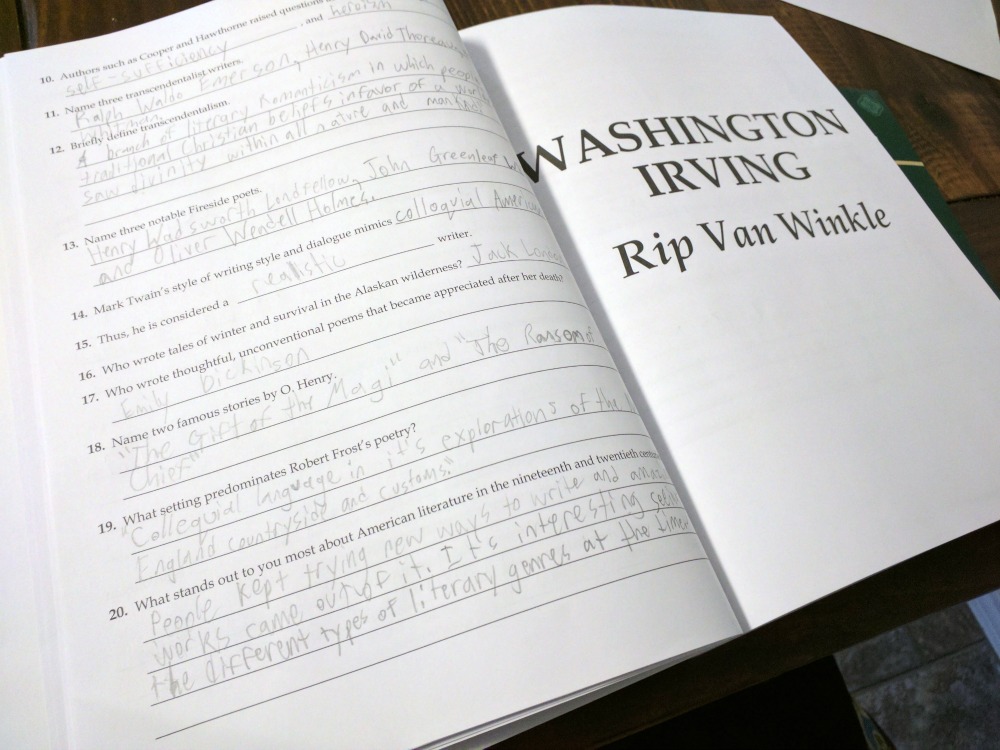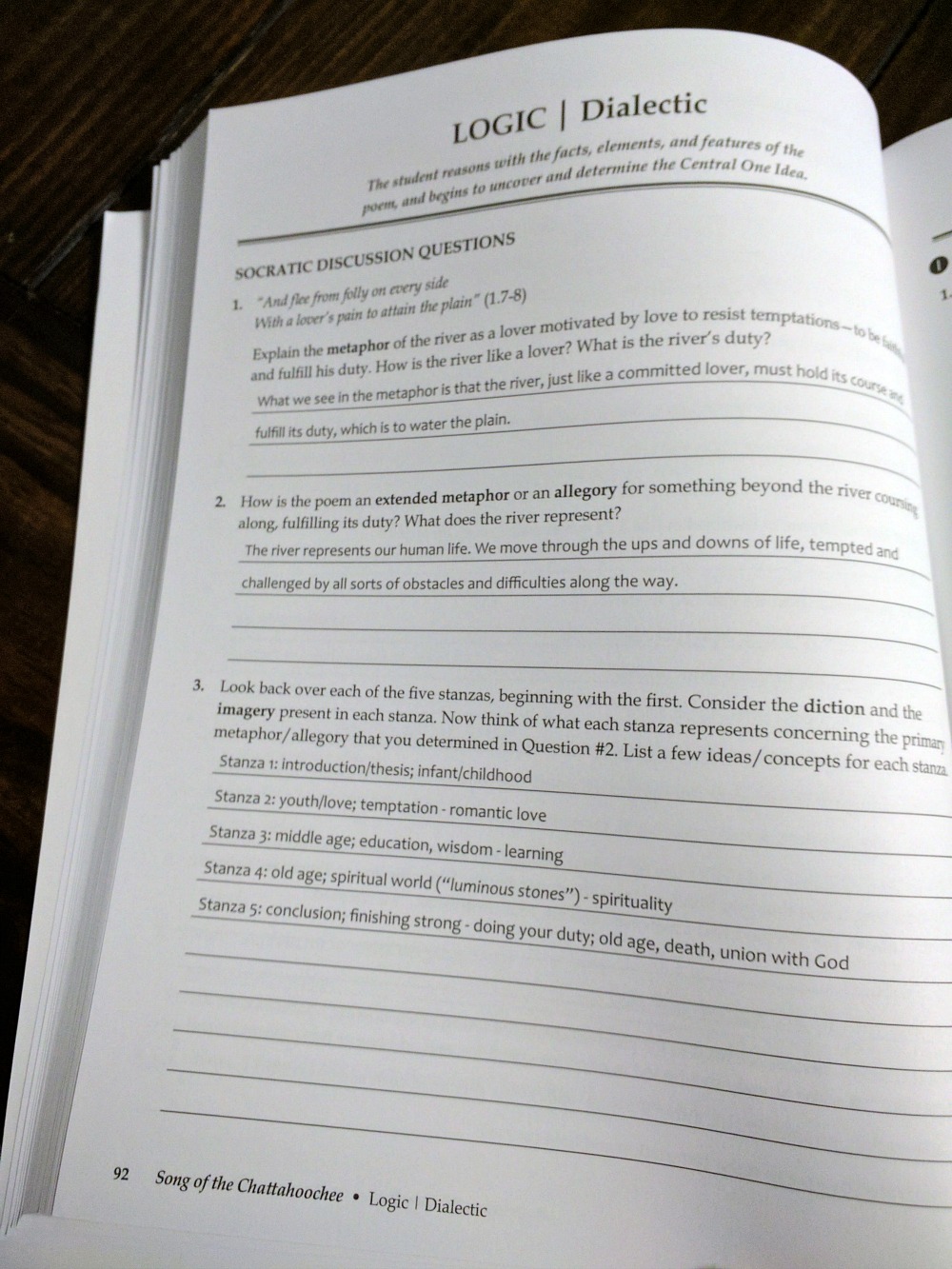I enjoy themed language arts resources, so I was eager to give the Poetry & Short Stories: American Literature Set a try for this review. The set from Memoria Press includes a study guide for the student, a teacher guide with answers to the study guide, and a small anthology of American short stories and poetry from the 19th and 20th centuries.

Recently, my daughter decided to begin her high school studies a little early and chose to start an American History course. This resource from Memoria Press fits in perfectly with what she is covering in history, and is giving her some insight into some terrific American Literature that she might not have been exposed to otherwise.
The Student Guide
If you are familiar with how Memoria Press puts their programs together, you will not be surprised to find that they have a methodical, routine-based, and very clear system for completing the work throughout the entire course. This is a 229 page softcover book.
The beginning of the book has a “How to Use This Study Guide With the Text” section with a step-by-step plan on how to approach the exercises in the student guide and the readings in the anthology. There is also a page of notes and instructions mirroring the “How to” page. Following those, there is an article called “Taking With Us What Matters: The Transformative Power of Reading for the Central Idea” and then “Four Stages to the Central One Idea: Using the Trivium to Uncover the Heart of a Work.”
I like that these are included. While some students may find it a bit confusing, the curriculum is designed for grades 7 and up, so they should be able to grasp most of what is being taught to them. It really helps them to develop a sense of what is meant when finding the central idea of a passage, particularly if the passage is rather long or perhaps a bit difficult to understand.

Students are then taught how to mark a book. This is to help students read the literature in the anthology and point out to themselves the most important passages. They’re encouraged to find the most important statements in the book, chapter, or article, and it has a special marking as well.
My daughter does not have a lot of experience with this, so it took her a few readings to get the hang of it. She referred back to the “How to Mark a Book” section each time, which works out well because it has a numbered order in which to do it, which she used as a sort of checklist for each piece of literature.

At the back of the Student Guide, there are also 10 forms for students to fill out and write on for the optional essay assignments. I like this because it includes the blank pages and the choices right in the workbook, so no extra notebook is needed if you’d like them to hand-write their essays.
There are 35 pieces of literature and poetry for students to discover in the 92 page, softcover anthology. There are American literature classics like “Rip Van Winkle” by Washington Irving and “The Gift of the Magi” by O. Henry and “The Road Not Taken” by Robert Frost.
In the appendix, there is British Poetry, and there are a few that I really loved reading too, like “The Owl and the Pussycat” by Edward Lear and “Amazing Grace” by John Newton. For each piece, Memoria Press has included a black and white copy of a painting or a photograph of the author as a fun little bonus while reading.
For each short story or poem, students will fill out many sheets in the Student Guide.
There is a place for:
Central Quote (this is done a little later, though it comes first in the worksheets)
Pre-Grammar Preparation (for students to think about the Central One Idea)
Grammar Presentation (to discover a few key details throughout the story or poem, including some vocabulary words and information on the author)
Words to be Defined (it includes a Definitions Bank as well as a hint as to which paragraph the word can be found)
a spot to remind them to mark the text
Comprehension Questions (multiple choice, true/false, short answer)
Logic Dialect (Socratic Discussion Questions to help students begin to determine what the Central One Idea is by reasoning with the facts and features of their assigned story)
and
Rhetoric Expression (where they finally use their own words to share the story or poem’s Central One Idea and support it with further information).
There is also an essay option for further language arts work.

I love how the program is laid out, and that I am able to use it as a supplement to our history program. It’s much more than just reading and answering questions, because it uses so many different approaches to digesting and analyzing the literature.

I think that a very motivated 7th or 8th grader would have no problem completing this, especially if they have some background with Classical Education and/or using Memoria Press guides. However, if your student is a bit more reluctant in language arts, I think it would be perfect for high school coursework. I will certainly be counting this toward high school credit for my daughter as it is so in-depth and rich.
Teacher Guide
The 283 page, softcover Teacher Guide includes all of the same pages as the Student Guide. It fills in all of the answers for the sections, except for the Central Quote and the Pre-Grammar Preparation section, since those are determined more by the student and their personal experiences.

The Teacher Guide also includes an Essay Section for up to 10 essays, with blank forms to write in the poem or story’s title, instructions on making the essay, many options/prompts for the essay (including a spot for the teacher to come up with their own prompt), and then 3 1/2 pages of lined paper for the student to write their essay.
Additionally, there are tests and answer keys for each piece of literature. The tests are matching and/or multiple choice.
Final Thoughts
I really do like this curriculum. It is reasonably priced at only $45 for the set, and it provides some great exposure and analysis of American Literature from the not so distant past. There are so many great pieces included, which always makes me feel good to know that my children are being exposed to some true classics!
I used this with my 8th grade daughter, and we broke it down into several days per piece. The short stories took a bit longer, but we’re working it into our full academic year, so there is plenty of time for us to take longer on those, and less time on the shorter poems.
The program is flexible, yet has a dependable and repetitive structure to complete the activities. I do recommend it as a stand-alone or supplemental resource for homeschooling families.
Memoria Press has a wonderful catalog of Classical Education homeschool curricula. To see what other families tried during the review period, click the banner below! Some of the reviewed products include Latin curricula, phonics, and poetry & prose.



